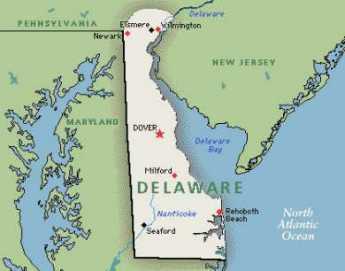Related Topics
Delaware (State of)
 Originally the "lower counties" of Pennsylvania, and thus one of three Quaker colonies founded by William Penn, Delaware has developed its own set of traditions and history.
Originally the "lower counties" of Pennsylvania, and thus one of three Quaker colonies founded by William Penn, Delaware has developed its own set of traditions and history.
Particular Sights to See:Center City
Taxi drivers tell tourists that Center City is a "shining city on a hill". During the Industrial Era, the city almost urbanized out to the county line, and then retreated. Right now, the urban center is surrounded by a semi-deserted ring of former factories.
Secret Places

|
| Winterthur |
Most mansions and other imposing places are clustered together in what would be called the high rent district. In the course of time, such areas often decline, but an occasional mansion remains nestled in a commercial or industrial area, or even in a slum. If it's accidentally well designed for such a fate, it might have an elaborate interior courtyard with a shabby exterior, or it might be in some cul-de-sac of a creek, or behind a hill. Unnoticed, it thrives as a social island. Eventually, someone notices the principle of hiding in plain sight, and creates a place like that deliberately.
Perhaps the most common examples of this approach are found in the "chateau district" of northern Delaware using what is called berms. These consist of large artificial hills which have been bulldozed up between the road and the chateau, effectively hiding them from passers-by. Both Winterthur and Longwood Gardens are hidden behind hills. If you get a chance to fly over the area in a private plane, you will be surprised to find that what looks like rolling rural countryside actually has quite a few mansions tucked away in it. It's safer that way, more private, less ostentatious. The DuPont family might even still harbor a few recollections of the French Revolution, or the barricades of the Paris Commune.
Up around Gulph Mills, the Drexel family had a place within a hidden valley, sort of like the crater of a volcano. The area nearby has since been built up with moderate-sized suburban houses, and between two of them is what looks like a driveway, going far to the back. In fact, it goes over the side of the bluff and down into a many-acred hollow. When you are inside the hollow, you could be a hundred miles into the wilderness and feel no more secluded. The only real problem with this arrangement is that visiting guests can be standing right in front of the entrance and never realize they have arrived; that's what cell phones help with. Global positioning (GPS) sounds ideal for the purpose, but when the trees are leafed out you are likely to think the GPS is broken. There is a farm in Germantown, behind LaSalle College, not far from Albert Einstein Medical Center. For tax purposes, it has a cow wandering around. Every once in a while LaSalle students think it is hugely amusing to steal the cow and put it on the top floor of a dormitory. But as you drive up Broad Street, most people would guess that the nearest cow is many miles away.
Although you have to go to New York to see the principle carried to its extreme, there are a number of places in downtown Philadelphia which combine the urban principle that doorways should be inconspicuous with the principle that if the streets are narrow, you really can't look upward very well. The New York example is right next to Carnegie Hall, seventy stories high but can't be seen from the street because of the angle. Furthermore, this apartment building occupies the center of the block but is turned so that only the corner of the building reaches the street. The entrance to this fanciest of fancy apartments is thus only one storefront wide, nestled inconspicuously among a long row of shops. Here again, the only problem is for visitors, because taxi drivers can't find it. To protect the innocent, we won't identify the places in center-city Philadelphia that use the same principles of concealment without exactly hiding.
Here's a tip. There are many houses next to parkland in Philadelphia where it is possible to see a dozen deer in the back yard, every morning. Forget about Lyme Disease; those are nice places to live.
Originally published: Monday, June 26, 2006; most-recently modified: Wednesday, June 05, 2019